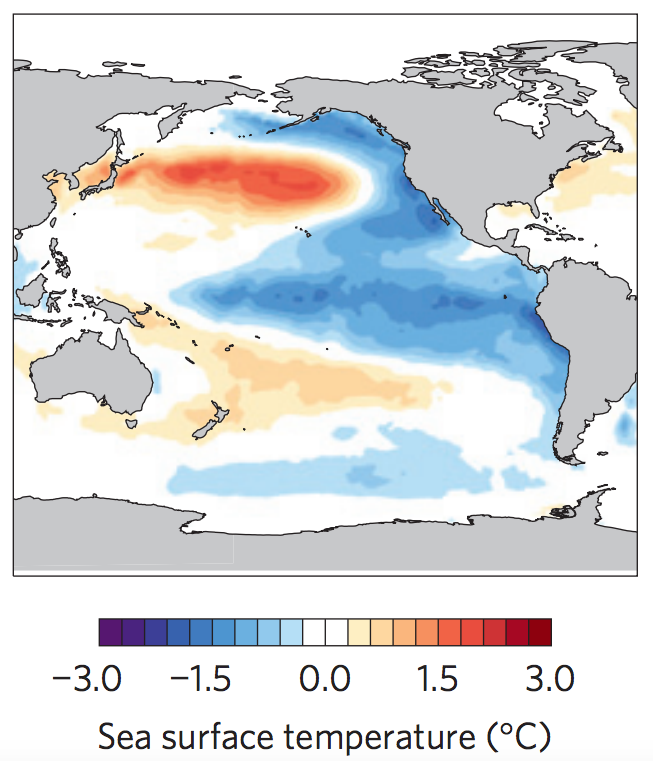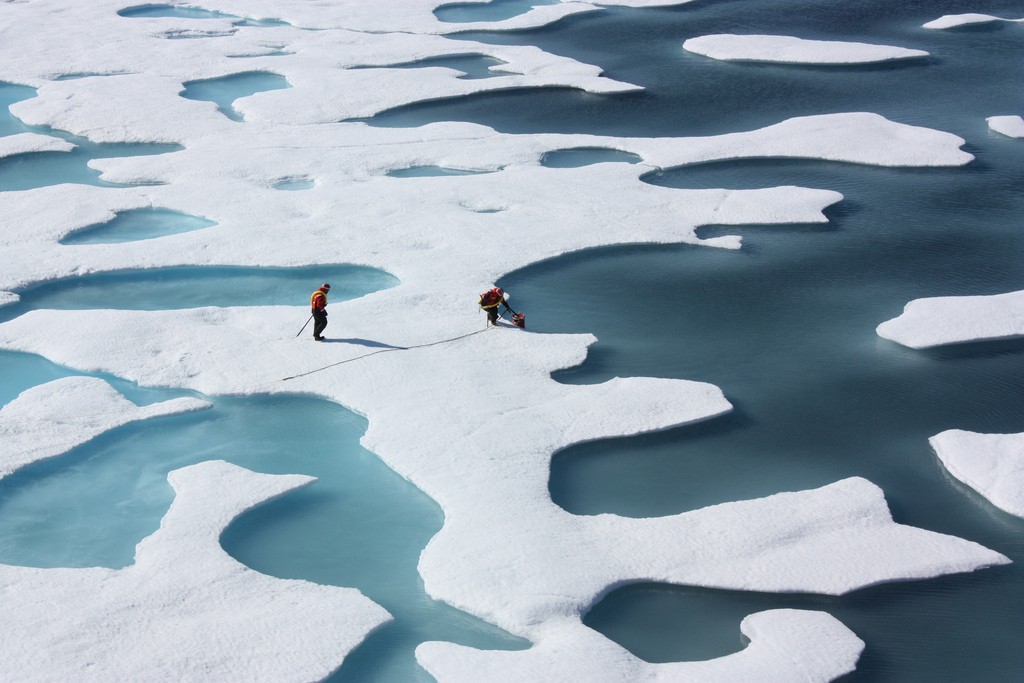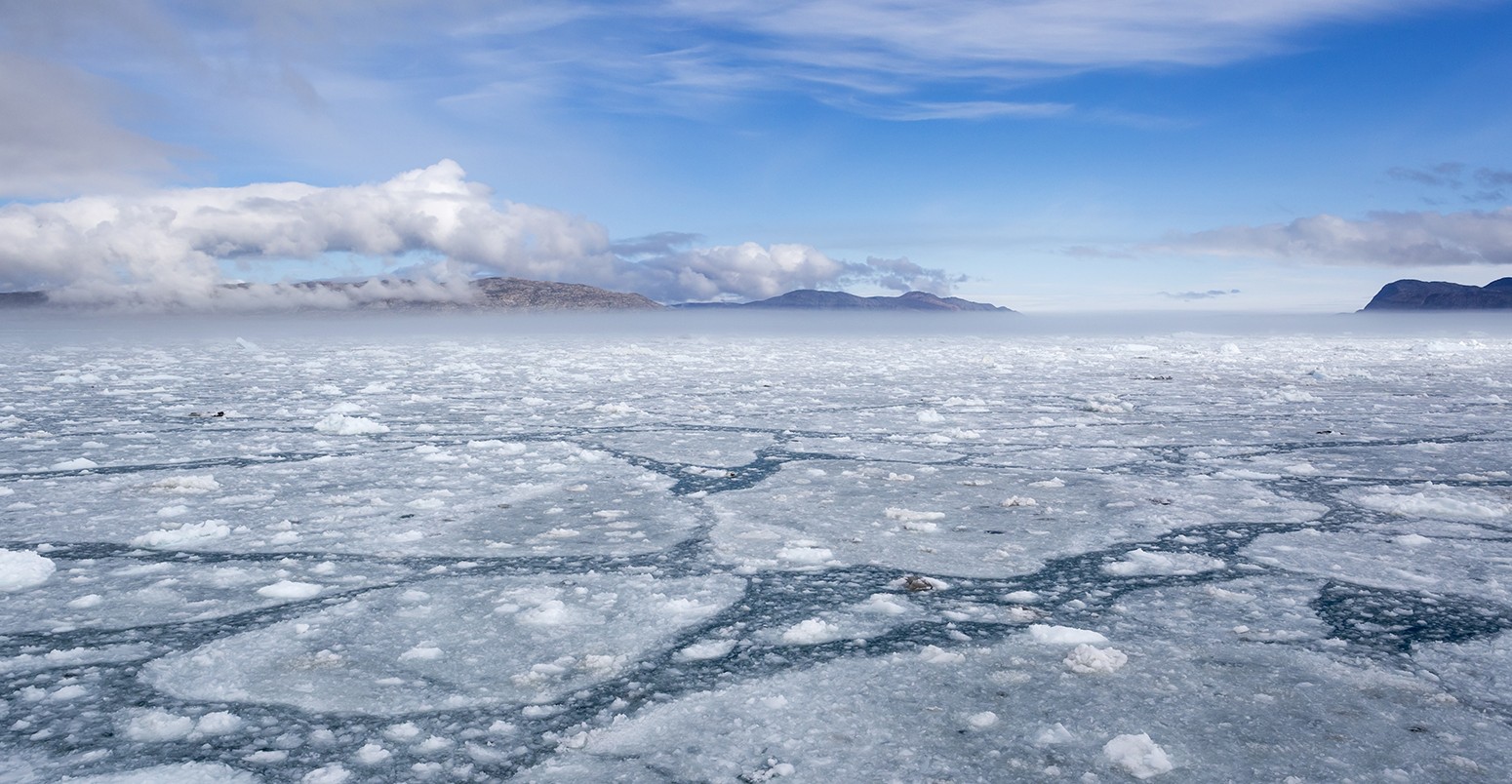Guest post: How the Pacific Ocean alters the pace of Arctic warming
Multiple Authors
05.05.16Multiple Authors
05.05.2016 | 11:42amA guest post from Dr James Screen, senior research fellow in the College of Engineering, Mathematics and Physical Sciences at the University of Exeter, and Prof Jennifer Francis, research professor in the Department of Marine and Coastal Sciences at Rutgers University.
Arctic temperatures are rising more than twice as fast as the global rate – a phenomenon known as Arctic amplification. The loss of sea ice – one of the most conspicuous aspects of human-caused climate change – is one of the main causes. As Arctic sea ice melts, energy from the sun that would have been reflected away by the ice is instead absorbed by the ocean.
While the underlying trend of rising temperatures is largely responsible for Arctic warming and sea ice melt, natural fluctuations in the climate system add bumps and wiggles along the way. How human-caused trends and natural variations interact each other is a hot research topic.
In our study, published this week in Nature Climate Change, we investigate how Arctic conditions respond to sea ice loss during the two opposite phases of a natural cycle in the Pacific Ocean called the Pacific Decadal Oscillation (PDO).
The results suggest that had the PDO been in a different phase this winter, the abnormally warm conditions recorded across the Arctic could have been even more pronounced.
Rapid shift
As its name suggests, fluctuations of the PDO typically occur over periods of up to a decade. In late 2013, the PDO shifted rapidly from its negative, cool phase to its positive, warm phase.
During a cold PDO phase, ocean temperatures along the west coast of North America and in the tropical Pacific tend to be colder than normal, while the North Pacific is warmer than usual. You can see this distinctive pattern of warm (red shading) and cold (blue shading) sea surface temperatures in the map below.
A warm PDO phase brings the opposite ocean temperature pattern – with warm waters along North America’s west coast and in the tropical Pacific, and colder waters in the North Pacific.

The negative phase of the PDO is linked to this distinctive pattern of warmer (red shading) and cooler (blue shading) Pacific Ocean temperatures. Source: Screen & Francis (2016).
The shift in PDO from cold to warm coincided with an unusually persistent and disruptive winter weather pattern over North America. The pattern combined the so-called “Ridiculously Resilient Ridge” over the western part of the continent, causing drought and abnormal warmth, and the “Terribly Tenacious Trough” in the east, responsible for record snows and prolonged cold.
Of course, the PDO has shifted phase naturally over the decades, but what’s different now is the vastly diminished Arctic sea ice cover.
We wondered how this flip in the PDO might affect the way the atmosphere responds to what is being called “The New Arctic” – an ocean with only half the sea ice it had only a generation ago.
Cause and effect
To tackle this question we turned to both observations of the real world and carefully designed modelling experiments. While the real world can give us clues to particular behaviours and relationships, it is always difficult to unravel cause-and-effect because many fluctuations and changes are happening at the same time.
A computer model of the atmosphere, however, can help isolate individual factors by running simulations that change only one thing at a time, such as sea ice extent or ocean temperature patterns. In this way, we simulated how the Arctic atmosphere responds to the loss of sea ice during the PDO’s two phases.
What we found surprised us: the PDO phase affects how much the Arctic warms in response to declining sea ice. More specifically, we found that when the PDO is in its cool or negative phase, the warming caused by the decline in sea ice is substantially larger than during the positive PDO phase. The extra warming is found almost exclusively over the Arctic.
So, why does this happen? Our findings suggest that it’s because air over open water during winter is much warmer than air over sea ice (which is why the loss of sea ice causes a local warming of the atmosphere).
In winter, when sea ice covers most of the Arctic Ocean, the areas where ice is being lost and where rapid warming is occurring are mainly along the ice edge, in the seas just outside the Arctic Circle. If that warmed air along the ice periphery is transported into the central Arctic, then it can contribute to a generally warmer Arctic.
We found that the efficiency of this transport is related to changes in wind patterns driven by the PDO. When the PDO is negative, winds blowing towards the Arctic are enhanced, as is the contribution of sea ice loss to Arctic warming.

On July 12, 2011, crew from the U.S. Coast Guard Cutter Healy retrieved a canister dropped by parachute from a C-130, which brought supplies for some mid-mission fixes. The ICESCAPE mission, or “Impacts of Climate on Ecosystems and Chemistry of the Arctic Pacific Environment,” is NASA’s two-year shipborne investigation to study how changing conditions in the Arctic affect the ocean’s chemistry and ecosystems. The bulk of the research takes place in the Beaufort and Chukchi seas in summer 2010 and 2011. Credit: NASA/Kathryn Hansen
Stronger warming
Our findings spell both good and bad news for the Arctic and beyond.
The good news is that by better understanding these interactions between natural and human-induced changes in the climate system, we can improve predictions for the Arctic and its surroundings.
The bad news is that the record-breaking Arctic warmth during this past winter occurred in a positive PDO phase. According to our results, therefore, if the PDO had been negative, that warming could have been even stronger.
The reasons for exceptional Arctic warmth this past winter are not yet clear, as several unusual factors were in play. A full post-mortem of the event will take time. But more importantly, when the PDO does shift back to its cool phase, we could see an acceleration of Arctic warming and likely also sea ice loss.
This is bad news indeed for a region that is already undergoing major change across the full spectrum of the system: atmosphere, ocean, ice, plants, animals and native people.
Main image: Arctic sea ice in Greenland.
Screen, J. A. and Francis, J. A. (2016) Contribution of sea-ice loss to Arctic amplification is regulated by Pacific Ocean decadal variability, Nature Climate Change, doi:10.1038/nclimate3011.


